Comba Telecom RX-8139 850MHz CDMA and UMTS Dual Mode Wireless Band Selective Repeater User Manual RX 8139 QE 1 0 0
Comba Telecom Ltd. 850MHz CDMA and UMTS Dual Mode Wireless Band Selective Repeater RX 8139 QE 1 0 0
PX8RX-8139 User Manual Rev2

_____________________________________________________________________________________________
8
85
50
0M
MH
HZ
Z
C
CD
DM
MA
A
A
AN
ND
D
U
UM
MT
TS
S
D
DU
UA
AL
L
M
MO
OD
DE
E
W
WI
IR
RE
EL
LE
ES
SS
S
B
BA
AN
ND
D
S
SE
EL
LE
EC
CT
TI
IV
VE
E
R
RE
EP
PE
EA
AT
TE
ER
R
USER MANUAL
RX-8139 QE: 1-0-0
Comba Telecom Ltd.
RX-
8
1
39

The information contained herein is the responsibility of and is approved by the
following, to whom all enquiries should be directed in the first instance:
This is an unpublished work the copyright in which vests in Comba International
("Comba"). All rights reserved.
The information contained herein is confidential and the property of Comba and is
supplied without liability for errors or omissions. No part may be reproduced,
disclosed or used except as authorised by contract or other written permission.
The copyright and the foregoing restriction on reproduction and use extend to all
media in which the information may be embodied.

USER MANUAL FOR RX-8139
ENU STATUS : 1-0-0 Copyright - refer to title page Page 3
0.1 CONTENTS
Section Page
0.1CONTENTS ........................................................................................................................... 3
0.2INDEX TO FIGURES AND TABLES ..................................................................................... 4
0.3HISTORY ............................................................................................................................... 5
0.4GLOSSARY OF TERMS ....................................................................................................... 6
0.5SAFETY NOTICES AND ADMONISHMENTS ...................................................................... 7
1GENERAL INFORMATION ................................................................................................... 9
2EQUIPMENT DESCRIPTION.............................................................................................. 10
2.1EQUIPMENT LAYOUT ........................................................................................................ 10
2.2KIT OF PARTS .................................................................................................................... 11
3INSTALLATION ................................................................................................................... 12
3.1WARNINGS AND ALERTS ................................................................................................. 12
3.2SITE PLANNING CONSIDERATIONS ................................................................................ 13
3.3INSTALLATION PROCEDURES ........................................................................................ 14
3.3.1GOODS INWARDS INSPECTION ...................................................................................... 14
3.3.2TOOLS ................................................................................................................................. 14
3.3.3PREPARATION ................................................................................................................... 14
3.3.4WALL MOUNTING .............................................................................................................. 15
3.3.5POLE MOUNTING OF MOUNTING RACK......................................................................... 16
3.3.6DRIP-LOOP ......................................................................................................................... 16
3.4EQUIPMENT CONNECTORS ............................................................................................ 17
3.4.1CONNECTORS ................................................................................................................... 17
3.4.2GROUNDING CONNECTION ............................................................................................. 18
3.4.3RF CONNECTION ............................................................................................................... 18
3.4.4EXTERNAL ALARM CONNECTION ................................................................................... 18
4COMMISSIONING ............................................................................................................... 19
4.1PRE-COMMISSIONING TASKS ......................................................................................... 19
4.2MCU LED INDICATORS ..................................................................................................... 19
4.3COMMISSIONING PROCEDURES .................................................................................... 20
5MAINTENANCE .................................................................................................................. 22
6APPENDICES...................................................................................................................... 23
6.1COMMISSIONING PROCEDURES .................................................................................... 23
6.2APPENDIX B: RMA (RETURN MATERIAL AUTHORIZATION) FORM ............................. 24

USER MANUAL FOR RX-8139
ENU STATUS : 1-0-0 Copyright - refer to title page Page 4
0.2 INDEX TO FIGURES AND TABLES
Figure 1: Views of RX-8139 Enclosure .........................................................................................................9
Figure 2: RX-8139 Internal Layout ............................................................................................................. 10
Figure 3: Mounting Rack Overview ............................................................................................................ 14
Figure 4: Wall Mounting ............................................................................................................................. 15
Figure 5: Pole Mounting Overview ............................................................................................................. 16
Figure 6: Bottom Panel Interface Diagram ................................................................................................ 17
Figure 7: LEDs ........................................................................................................................................... 19
Table 1: Equipment KOP ........................................................................................................................... 11
Table 2: Cable Connection ........................................................................................................................ 13
Table 3: LED Indicators ............................................................................................................................. 19
Table 4: Commissioning ............................................................................................................................ 21

USER MANUAL FOR RX-8139
ENU STATUS : 1-0-0 Copyright - refer to title page Page 5
0.3 HISTORY
Change No. ENU Details Of Change
1 1-0-0 RX-8139 user manual first created in June 2012 and referred to its
Chinese manual RX-8139-1001YH.

USER MANUAL FOR RX-8139
ENU STATUS : 1-0-0 Copyright - refer to title page Page 6
0.4 GLOSSARY OF TERMS
ALC Automatic Level Control
ATT Attenuation
AFC Antenna Feedback Cancellation
BTS Base Transceiver Station
dB Decibel
dBm Decibels relative to 1 milliwatt
DL Downlink
DPX Duplexer
DT Donor Terminal
FSK Frequency Shift Keying
GSM Global Standard for Mobile Communication
Hz Hertz
ID Identification
LNA Low Noise Amplifier
MCU Main Control Unit
MHz Megahertz
MT Mobile Terminal
MTBF Mean Time Between Failures
NF Noise Figure
OMC Operation & Maintenance Center
OMT Operation & Maintenance Terminal
OP Optical Fiber
PA Power Amplifier
PLL Phase Locked Loop
PSU Power Supply Unit
RF Radio Frequency
RX Receive
SMA Sub-Miniature “A” Connector
SIU Slide-In-Unit
TX Transmit
UL Uplink
VAC Volts Alternating Current
VSWR Voltage Standing Wave Ratio

USER MANUAL FOR RX-8139
ENU STATUS : 1-0-0 Copyright - refer to title page Page 7
0.5 SAFETY NOTICES AND ADMONISHMENTS
This document contains safety notices in accordance with appropriate standards. In the interests of
conformity with the territory standards for the country concerned, the equivalent territorial admonishments
are also shown.
Any installation, adjustment, maintenance and repair of the equipment must only be carried out by trained,
authorized personnel. At all times, personnel must comply with any safety notices and instructions.
Specific hazards are indicated by symbol labels on or near the affected parts of the equipment. The
labels conform to international standards, are triangular in shape, and are coloured black on a yellow
background. An informative text label may accompany the symbol label.
Hazard labeling is supplemented by safety notices in the appropriate equipment manual. These notices
contain additional information on the nature of the hazard and may also specify precautions.
Warning:
These draw the attention of personnel to hazards that may cause death or injury to the operator or others.
Examples of use are cases of high voltage, laser emission, toxic substances, point of high temperature,
etc.
Alert:
These draw the attention of personnel to hazards that may cause damage to the equipment. An example
of use is the case of static electricity hazard.
Caution notices may also be used in the handbook to draw attention to matters that do not constitute a
risk of causing damage to the equipment but where there is a possibility of seriously impairing its
performance, e.g. by mishandling or gross maladjustment. Warnings and Cautions within the main text
do not incorporate labels and may be in shortened form.
CAUTION: danger of explosion if battery is incorrectly replaced. Replace only with the same or
equivalent type.
Caution:
The user is cautioned that changes or modifications not expressly approved by the party
responsible for compliance could void the user's authority to operate the equipment.
This device complies with Part 15 of the FCC Rules. Operation is subject to the condition that this device
does not cause harmful interference.
NOTE:
This equipment has been tested and found to comply with the limits for a Class A digital device,
pursuant to Part 15 of the FCC Rules. These limits are designed to provide reasonable protection against
harmful interference when the equipment is operated in a commercial environment. This equipment
generates, uses, and can radiate radio frequency energy and, if not installed and used in accordance
with
the instruction manual, may cause harmful interference to radio communications. Operation of this
equipment in a residential area is likely to cause harmful interference in which case the user will be
required to correct the interference at his own expense.
To comply with FCC RF exposure requirements, the device and the antenna for this device must be
installed to ensure a minimum separation distance of 1.9 meters or more from a person's body. Other
operating configurations should be avoided.
End of Section

USER MANUAL FOR RX-8139
ENU STATUS : 1-0-0 Copyright - refer to title page Page 8
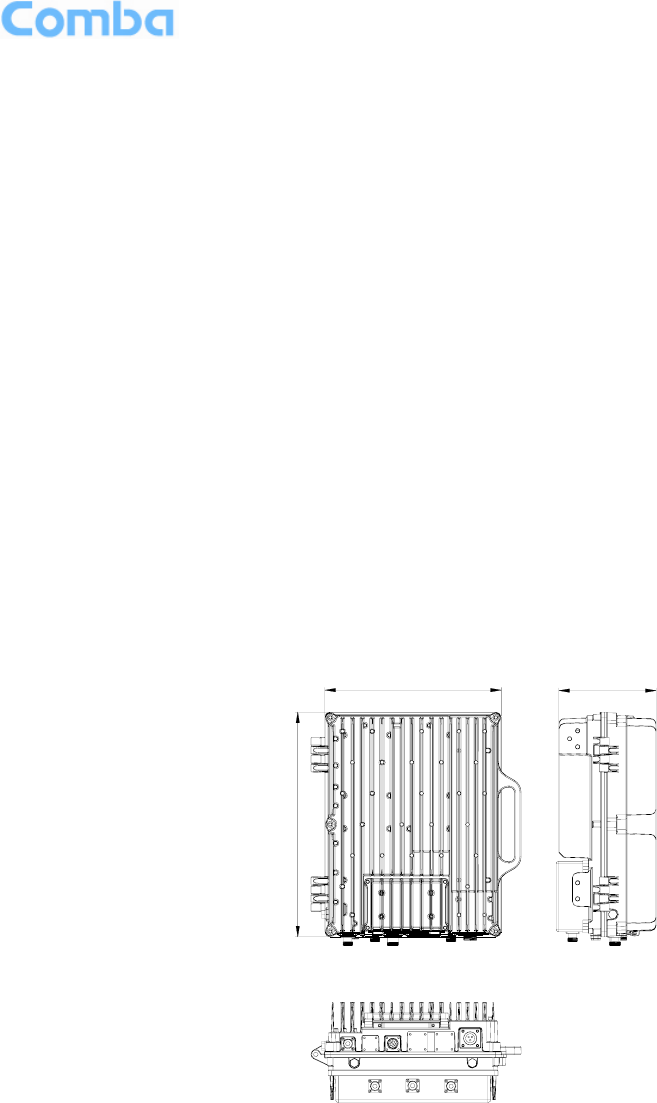
USER MANUAL FOR RX-8139
ENU STATUS : 1-0-0 Copyright - refer to title page Page 9
1 GENERAL INFORMATION
RX-8139 850MHz CDMA and UMTS Dual Mode Wireless Band Selective Repeater (hereinafter called
“RX-8139”) is designed for 850MHz network. Working frequency and working system can be customized
for flexible configuration.
Characteristics of RX-8139 are as follows:
• Supports 7.5 MHz of CDMA subband and 5 MHz of WCDMA subband.
• Allows DL VSWR alarm, DL input field intensity detect and output power detect functions, easy for
installation.
• Automatic gain temperature compensation function which can maintain regular operation among
working temperature.
• Local Operation and Maintenance Terminal (OMT): operating status and parameters can be set or
monitored by OMT PC locally. It can also check the downlink power and download the latest OMT
version.
• Operation Maintenance Center (OMC): system working parameters and communication configuration
can be set or inquired remotely through Ethernet cable.
• Designed for all weather outdoor application – waterproof, damp-proof and Omni-sealed.
The following figure shows the enclosure of the RX-8139.
420
330 182
Figure 1: Views of RX-8139 Enclosure
End of Section
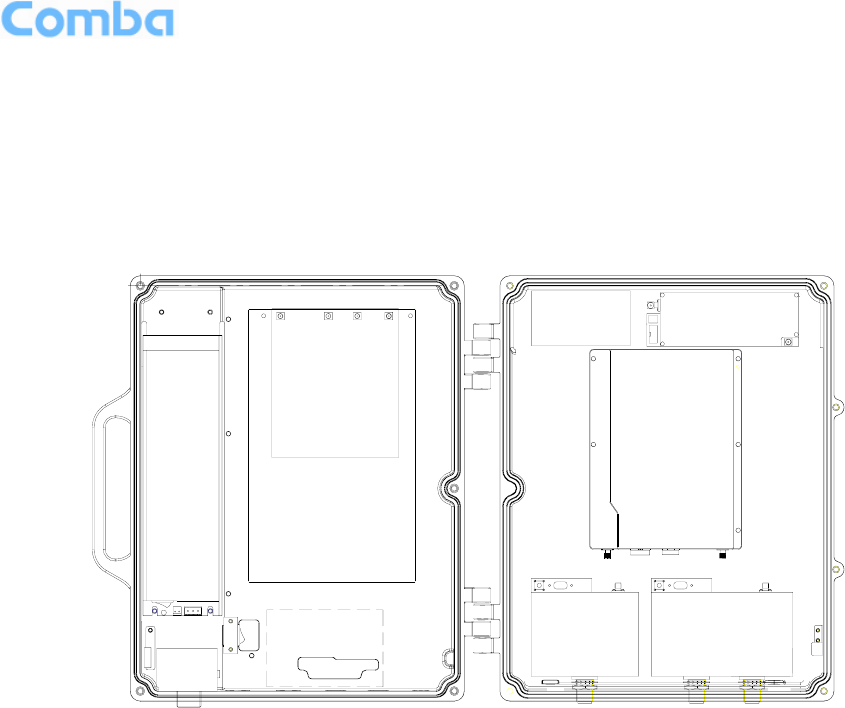
USER MANUAL FOR RX-8139
ENU STATUS : 1-0-0 Copyright - refer to title page Page 10
2 EQUIPMENT DESCRIPTION
2.1 EQUIPMENT LAYOUT
The following figure shows RX-8139 internal layout.
Li-ion Battery
Managed
Module
UL PA
DL PA
MT Filter
DT Integrated
Duplexer
Surge
Arrestor
PSU
Integrated
Module
ANT
X2
Figure 2: RX-8139 Internal Layout
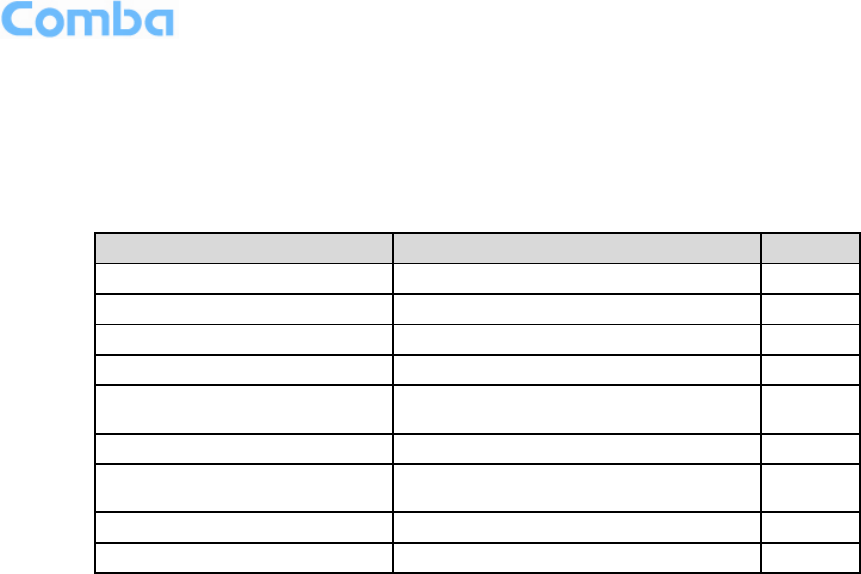
USER MANUAL FOR RX-8139
ENU STATUS : 1-0-0 Copyright - refer to title page Page 11
2.2 KIT OF PARTS
For this system, the following are shipped:
Table 1: Equipment KOP
Product Identifier Description Quantity
RX-8139 manual This equipment manual on CD-Rom 1
CPC Connector X14J7P 1
Ethernet Cable 2m 1
Masonry Bolt M8x80 4
U Bolt (with 2 nuts, flat washer,
spring washer per bolt) M10x85x110 2
Power Supply Cable n/a 1
T-shape Pentagon Screw
Wrench 5mm 1
OMT V5.0 or above OMT software on CD-Rom 1
Factory Test Report N/A 1
End of Section

USER MANUAL FOR RX-8139
ENU STATUS : 1-0-0 Copyright - refer to title page Page 12
3 INSTALLATION
3.1 WARNINGS AND ALERTS
Radio Frequency Energies
There may be situations, particularly for workplace environments near high-powered RF sources, where
recommended limits for safe exposure of human beings to RF energy could be exceeded. In such cases,
restrictive measures or actions may be necessary to ensure the safe use of RF energy.
High Voltage
The equipment has been designed and constructed to prevent, as far as reasonably, practicable danger.
Any work activity on or near equipment involving installation, operation or maintenance must be, as far as
reasonably, free from danger.
Where there is a risk of damage to electrical systems involving adverse weather, extreme temperatures,
wet, corrosive or dirty conditions, flammable or explosive atmospheres, the system must be suitably
installed to prevent danger.
Protective Earthing
Equipment provided for the purpose of protecting individuals from electrical risk must be suitable for the
purpose and properly maintained and used.
Handling Precautions
This covers a range of activities including lifting, lowering, pushing, pulling, carrying, moving, holding or
restraining an object, animal or person. It also covers activities that require the use of force or effort, such
as pulling a lever, or operating power tools.
Electrostatic Discharge (ESD)
Observe standard precautions for handling ESD-sensitive devices. Assume that all solid-state electronic
devices are ESD-sensitive. Ensure the use of a grounded wrist strap or equivalent while working with
ESD-sensitive devices. Transport, store, and handle ESD-sensitive devices in static-safe environments.

USER MANUAL FOR RX-8139
ENU STATUS : 1-0-0 Copyright - refer to title page Page 13
3.2 SITE PLANNING CONSIDERATIONS
Site Considerations
The site considerations are listed below:
• The distance between the donor antenna and the BS should satisfy line of sight requirements for
maximum coverage area. The received spots accept field intensity at least -70dBm.
• Make sure that TX and RX antennas isolation should more than the max gain that of -15dB.
• Supply power near by the BS and easily access to the grounding spot.
Installation Location
Mounting surface shall be capable of supporting the weight of the equipment.
In order to avoid electromagnetic interference, a proper Mounting location must be selected to minimize
interference from electromagnetic sources such as large electrical equipment.
Chassis output interface should install higher 1.2m than the ground.
Environmental
Humidity has an adverse effect on the reliability of the equipment. It is recommended to install the
equipment in locations having stable temperature and unrestricted air-flow which should under the
temperature that of -33oC ~+55oC and relative humidity of maximal 95%.
The installation location for the product should be well ventilated. The equipment has been designed to
operate at the temperature range and humidity level as stated in the product specifications in the
datasheet.
Direct sun light exposure to the equipment should be avoided. Provide additional shelter if necessary.
Powering
The power supply unit (PSU) provides power to all modules within the equipment. Depending on the
product variant, it is recommended that the PSU operates on a dedicated circuit breaker or fused circuit.
Grounding Requirement
Verify that the equipment has been well grounded. This includes antennas and all cables connected to
the system. Ensure lightning protection for the antennas is properly grounded.
Cable Routing
Depending on equipment configuration, a variety of types of cables are required. Where applicable,
ensure cables are properly routed and secured so that they are not damaged.
Cable requirements are as follow:
Table 2: Cable Connection
Cable Connection Description
Coaxial Cable N to N Connect BS cable to DT port
Coaxial Cable N to N Connect serve antenna cable
to MT port
Local Commissioning Cable RJ45 Connect with PC to realize local
commissioning
Manual Handling
During transportation and installation, take necessary handling precautions to avoid potential physical
injury to the installation personnel and the equipment.

USER MANUAL FOR RX-8139
ENU STATUS : 1-0-0 Copyright - refer to title page Page 14
3.3 INSTALLATION PROCEDURES
3.3.1 GOODS INWARDS INSPECTION
z Verify the number of packages received against the packing list.
z Check all packages for external damage; report any external damage to the shipping courier. If there
is damage, a shipping agent should be present before unpacking and inspecting the contents
because damage caused during transit is the responsibility of the agent.
z Open and check each package against the packing list. If any items are missing, please contact
Comba.
z Do not remove items from antistatic packing until ready for installation. If damage is discovered at the
time of installation, contact the shipping agent.
3.3.2 TOOLS
See Appendix A for a full list of the recommended tools required for installation and maintenance.
3.3.3 PREPARATION
z Wall mounting with the masonry bolts supplied, which make use of the outer holes.
z Pole Mounting with the clamp kit supplied, which make use of the inner holes.
236
186
200
Figure 3: Mounting Rack Overview
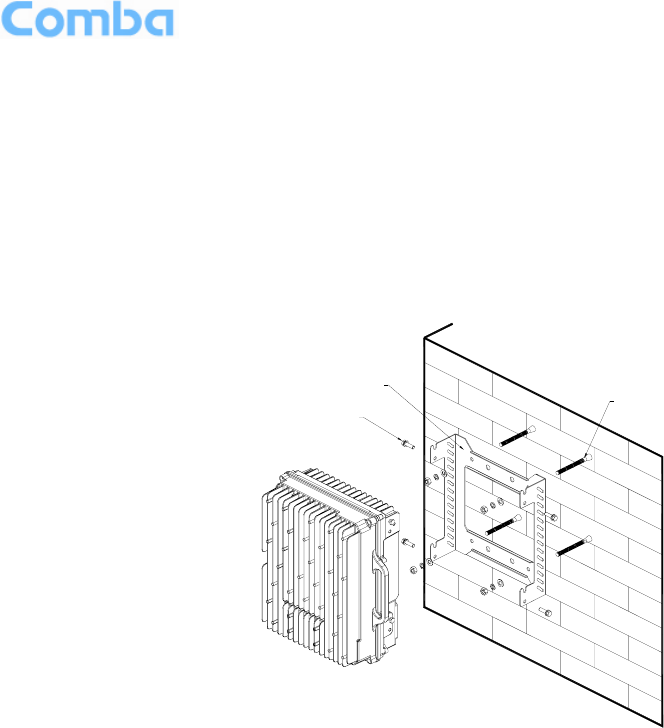
USER MANUAL FOR RX-8139
ENU STATUS : 1-0-0 Copyright - refer to title page Page 15
3.3.4 WALL MOUNTING
z Drill holes on the wall by using the position of the four round holes on the Mounting rack as a guide.
z Insert the masonry bolts through the round holes and tighten them to take the weight of the entire
enclosure.
z Hook the enclosure up onto the mounting rack and align the hole positions to that of the mounting
rack, then installed the hex socket bolt to complete the installation.
M8 Masonry Bolt
Mounting Rack
M8 Hex Socket Bolt
Figure 4: Wall Mounting
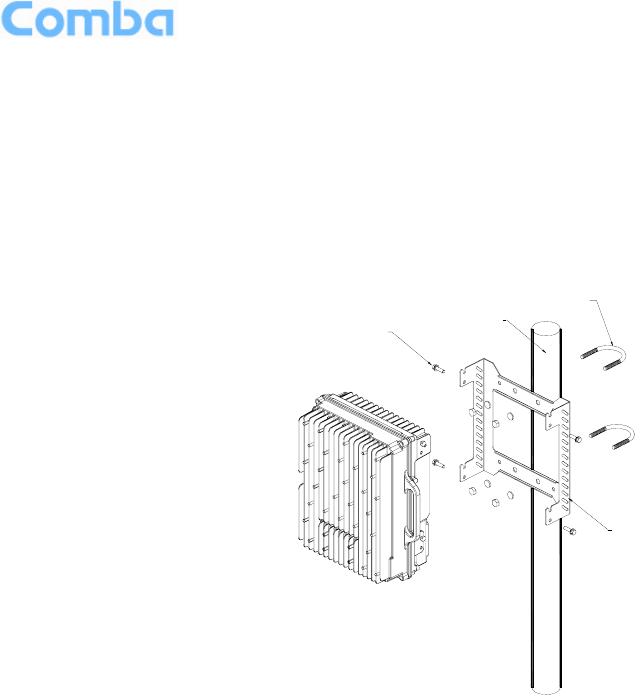
USER MANUAL FOR RX-8139
ENU STATUS : 1-0-0 Copyright - refer to title page Page 16
3.3.5 POLE MOUNTING OF MOUNTING RACK
z The equipment can be mounted on a pole of about 60~75mm in diameter.
z Insert and tighten the two U bolts to secure the mounting rack onto the pole.
z The remaining installation to secure the enclosure to the mounting rack is identical to wall mounting.
U Bolt
Pole
Mounting Rack
M8 Hex Socket Bolt
Figure 5: Pole Mounting Overview
3.3.6 DRIP-LOOP
Comba recommends that every horizontal cable entry to the equipment forms a 'U' before its entry to the
equipment. Water on the cable will drip down at the bottom of the loop and will not accumulate at the
equipment connectors.
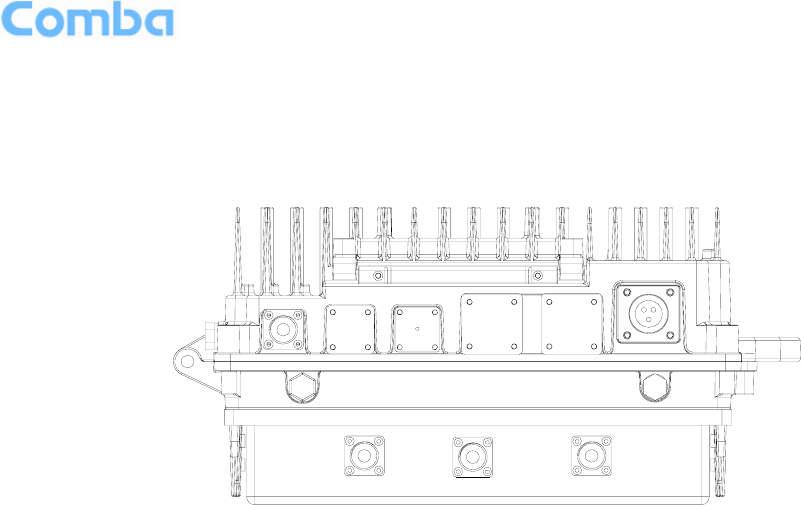
USER MANUAL FOR RX-8139
ENU STATUS : 1-0-0 Copyright - refer to title page Page 17
3.4 EQUIPMENT CONNECTORS
3.4.1 CONNECTORS
.
EXT_ALM
POWER
DT TX
RX
Figure 6: Bottom Panel Interface Diagram

USER MANUAL FOR RX-8139
ENU STATUS : 1-0-0 Copyright - refer to title page Page 18
3.4.2 GROUNDING CONNECTION
Ground Connection
To ensure safe operation of the product, a ground (earth) connection is required. For single phase AC
power source, the product must be grounded by connecting the “earth wire” of the power cord to the
ground terminal of the AC supply.
3.4.3 RF CONNECTION
z Donor antenna connection: Connect the cable form donor antenna to DT port
z Mobile antenna connection: Connect the cable form mobile antenna to MT port
3.4.4 EXTERNAL ALARM CONNECTION
The external alarm port is used to connect with other external equipment and alarm ports. Connection is
not must in case there is no external alarm port.
End of Section

USER MANUAL FOR RX-8139
ENU STATUS : 1-0-0 Copyright - refer to title page Page 19
4 COMMISSIONING
4.1 PRE-COMMISSIONING TASKS
After equipment installation, perform the following steps before equipment powering and commissioning,
check that the expected voltage, current, and power levels do not violate any ratings. Double check all
connections including ground before applying power. Do not manipulate circuits or make changes when
power is applied:
• Visually inspect the power connection within the equipment. Ensure that the power cable is correctly
and securely connected, including grounding wire, RF cable and optical cable.
• Check grounding connection and verify that the ground resistance is less than 5Ω.
• Connect the equipment to the PC installed with OMT software.
• Check antenna system return loss which working frequency band return loss should less than -14dB
(VSWR < 1.5)
• The online commissioning can be commenced with following the commissioning steps.
4.2 MCU LED INDICATORS
Three diagnostic LEDs are located on integrated module; each indicates the status of a particular
function:
LED_ALARM
LED_MODEM
LED_RUN
Figure 7: LEDs
Table 3: LED Indicators
Identifier Colour Indication
LED_RUN Green
Operation indicator – Flashes once every second to
indicate normal system operation.
LED_ALARM Red Alarm indicator. ON = alarm; OFF = no alarm
LED_MODEM Red N/A
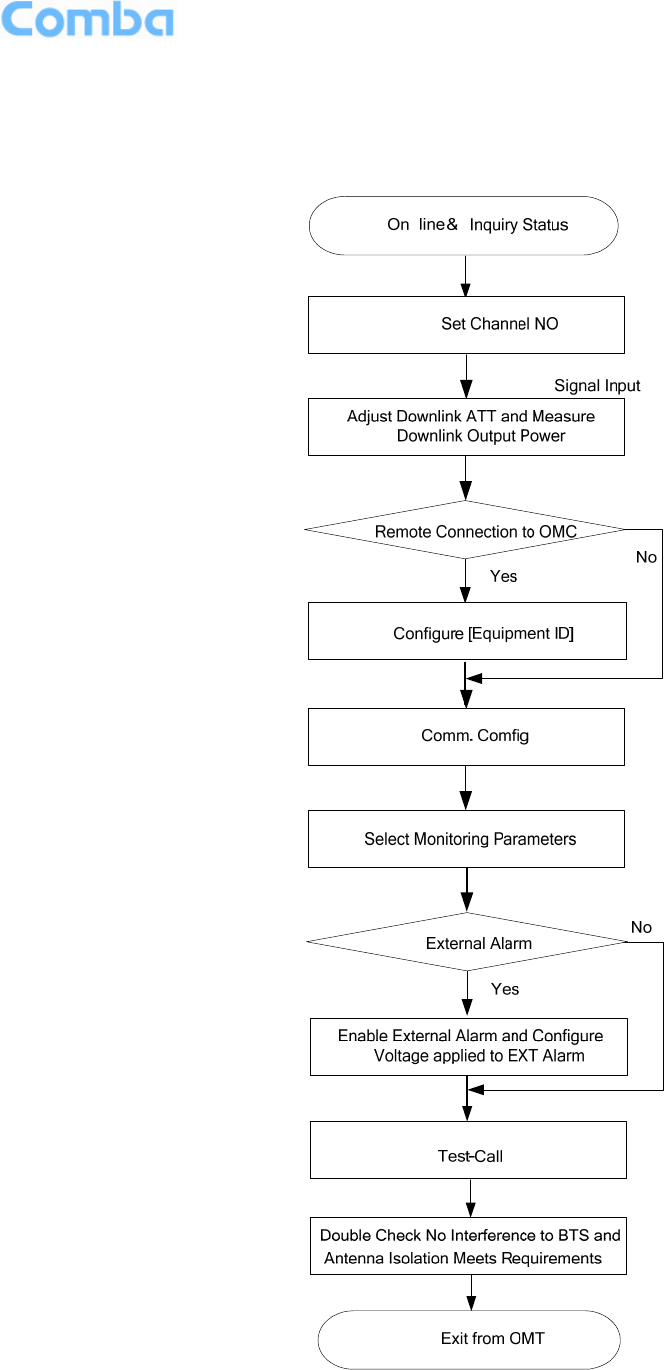
USER MANUAL FOR RX-8139
ENU STATUS : 1-0-0 Copyright - refer to title page Page 20
4.3 COMMISSIONING PROCEDURES
Perform the following procedures for system commissioning.

USER MANUAL FOR RX-8139
ENU STATUS : 1-0-0 Copyright - refer to title page Page 21
Table 4: Commissioning
Commissioning Tasks Observation
1. On-line and Inquiry status
z Activate the OMT Main window. The system Initialization will
completed in about 2 minutes.
z Click “Connect” button to enquire the repeater’s status. Proceed if
there is no alarm; else check the failure and attend to the alarm.
2. Set Channel No.
z Keep RF switch ON and set the channel number of the repeater’s
operating frequency.
3. Adjust Downlink Output
Power and align donor
antenna
z Observe DL input power from measured value. Align the direction
of donor antenna until the DL input power reading is maximized.
z Note: To ensure that the measured DL input power is accurate, one
should set the DL ATT to “0” before performing the check.
4. Configure [Equipment ID] z Go to [Properties Info] and set [Equipment ID].
5. Comm. Config
z Enable the power supply by selecting “On” in [RF] -> [Switch]; go to
[Properties Info.] -> [Comm. Config.] and set OMC Phones No. , the
service No. of SMSC, Report Mode.
6. Select Monitoring
Parameters
z Select the equipment controlled and monitored parameters.
z If the external devices are connected to the equipment for
management, please enable in the [External Alarm Info.] Interface.
7. Test coverage area field
intensity and adjust
service antenna.
z Use test-handset to verify field intensity within the coverage area. If
needed, realign the service antenna to achieve the desired
coverage.
z Note: If during operation, the equipment gain could not be set to
maximum or the output power is not high enough due to insufficient
donor and service antennas isolation, then the antennas’ position
should be changed to increase isolation. If the output power is too
high and ALC is activated, then adjust the DL ATT to achieve
optimal DL Gain.
8. Verify UL gain and ensure
test call produces good
voice quality and there is
no interfering BTS
z Adjust UL gain and perform test calls. Typically, the UL gain is set
around 5dB less than DL gain. Perform test calls in the coverage
area while adjusting UL gain if required.
z Note: If the repeater is near the BTS and the test call performance
is poor, this may be due to UL noise interference to the BTS. Users
can calculate and determine if the repeater UL noise will interfere
with the BTS.
z Verify again that there is no unacceptable interference to BTS.
End of Section

USER MANUAL FOR RX-8139
ENU STATUS : 1-0-0 Copyright - refer to title page Page 22
5 MAINTENANCE
The RX-8139 repeater is designed for trouble-free operation and generally does not need maintenance.
Maintenance activities should only be carried out by trained personnel.
The equipment operation status can be observed remotely through OMC.
Periodic inspection of the repeater equipment(s) is recommended, the recommended tasks includes:
z Inspect and record operation status and output power of the repeater from OMC or OMT.
z Verify the direction and position of antennas. Re-align if necessary.
z Make sure the cable gland and sealing on the RF cable connectors are not damaged.
z Verify lightning and grounding protection is in good condition.
End of Section

USER MANUAL FOR RX-8139
ENU STATUS : 1-0-0 Copyright - refer to title page Page 23
6 APPENDICES
6.1 COMMISSIONING PROCEDURES
The following are the recommended list of tools new installation and routine maintenance:
• Slotted screwdriver
• Philips screwdriver
• Ring spanner (Assorted size: 12~20mm)
• Electrically operated drill and masonry drill bits ∅10mm
• Anti-static wrist strap
• Allen key (M5.5)
• Side cutter
• Frequency counter (e.g. FLUKE PM6685R)
• RF Power Meter (e.g. Bird 5000)
• T-shaped Pentagon Key Wrench
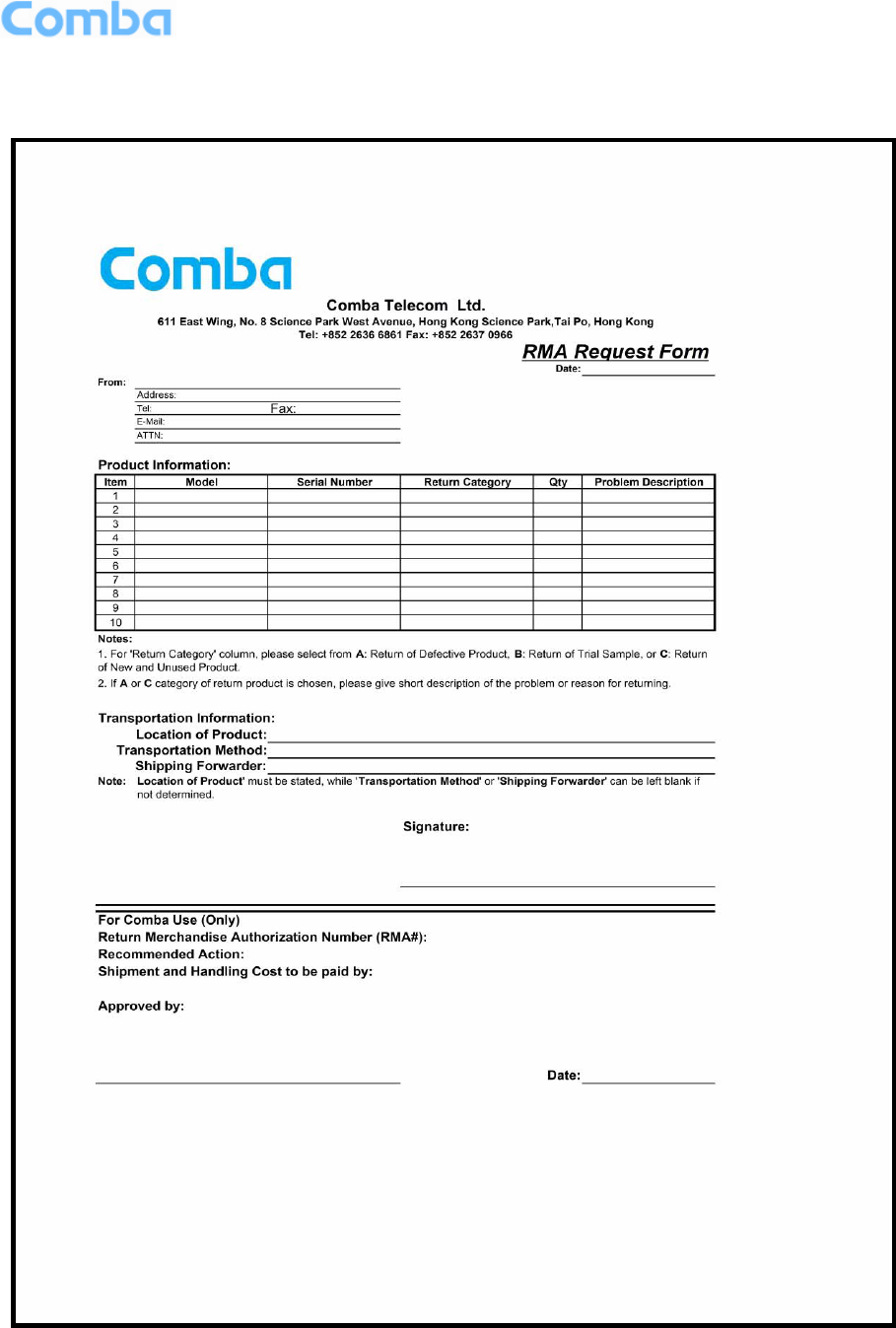
USER MANUAL FOR RX-8139
ENU STATUS : 1-0-0 Copyright - refer to title page Page 24
6.2 APPENDIX B: RMA (RETURN MATERIAL AUTHORIZATION) FORM
End of Section
End of Document
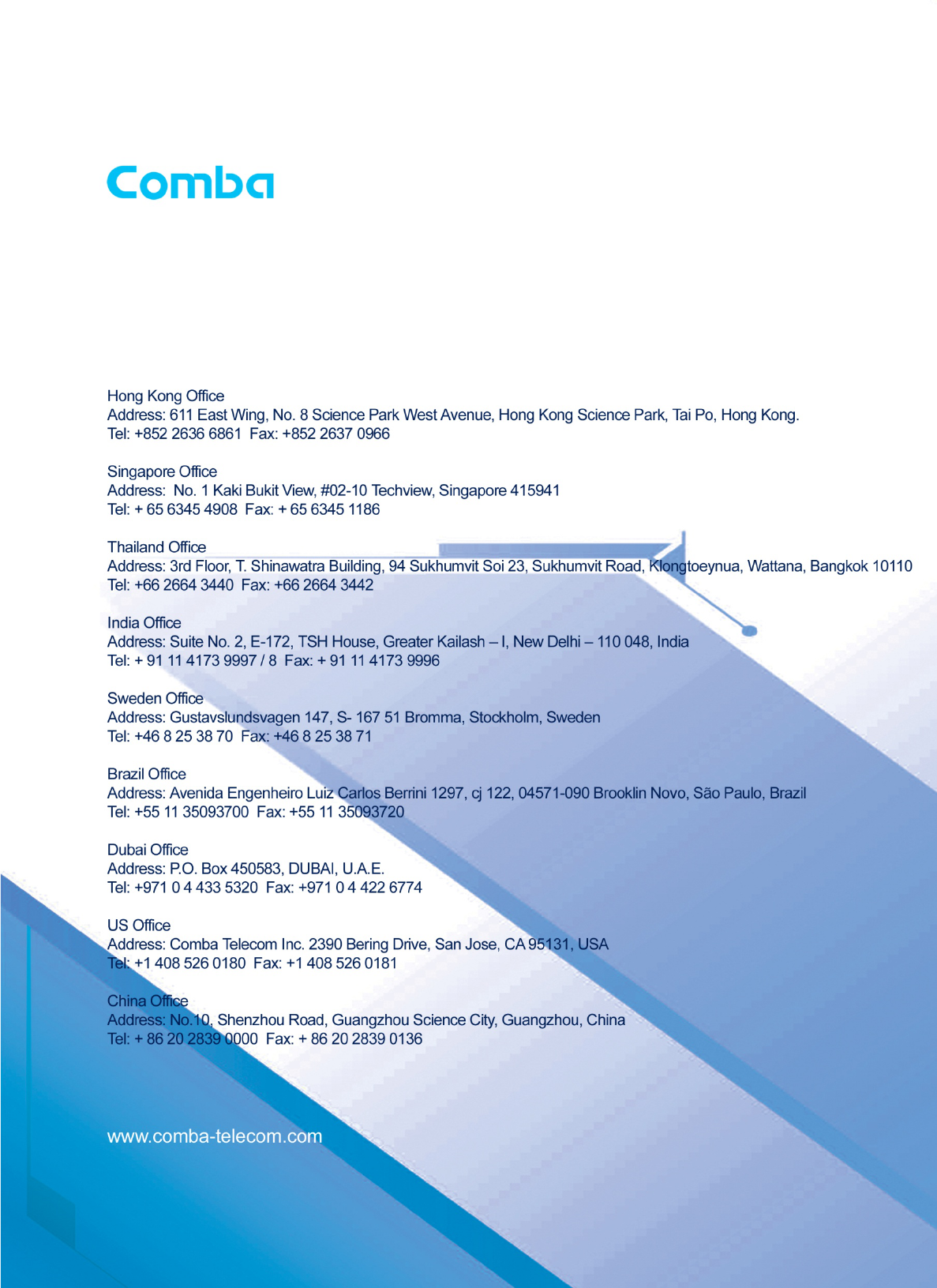
USER MANUAL FOR RX-8139
ENU STATUS : 1-0-0 Copyright - refer to title page Page 25